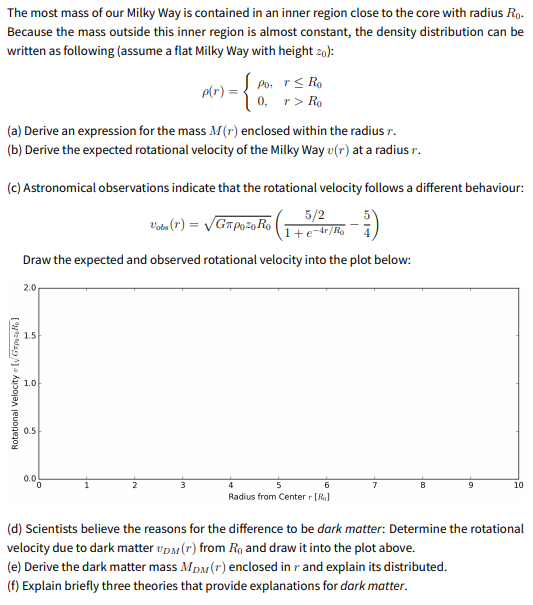The most mass of our Milky Way is contained in an inner region close to the core with radius Ro- Because the mass outside this inner region is almost constant, the density distribution can be written as following (assume a flat Milky Way with height z0): 0, r> Ro (a) Derive an expression for the mass M(r) enclosed within the radius r. (b) Derive the expected rotational velocity of the Milky Way v(r) at a radius r. (c) Astronomical observations indicate that the rotational velocity follows a different behaviour: 5/2 Vata (r) = VGapoz0R ( Draw the expected and observed rotational velocity into the plot below:
The most mass of our Milky Way is contained in an inner region close to the core with radius Ro- Because the mass outside this inner region is almost constant, the density distribution can be written as following (assume a flat Milky Way with height z0): 0, r> Ro (a) Derive an expression for the mass M(r) enclosed within the radius r. (b) Derive the expected rotational velocity of the Milky Way v(r) at a radius r. (c) Astronomical observations indicate that the rotational velocity follows a different behaviour: 5/2 Vata (r) = VGapoz0R ( Draw the expected and observed rotational velocity into the plot below:
Related questions
Question
The qs was solved here.urgent pls

Transcribed Image Text:The most mass of our Milky Way is contained in an inner region close to the core with radius Ro-
Because the mass outside this inner region is almost constant, the density distribution can be
written as following (assume a flat Milky Way with height z0):
0, r> Ro
(a) Derive an expression for the mass M(r) enclosed within the radius r.
(b) Derive the expected rotational velocity of the Milky Way v(r) at a radius r.
(c) Astronomical observations indicate that the rotational velocity follows a different behaviour:
5/2
Vata (r) = VGapoz0R (
Draw the expected and observed rotational velocity into the plot below:
Expert Solution
This question has been solved!
Explore an expertly crafted, step-by-step solution for a thorough understanding of key concepts.
Step by step
Solved in 2 steps with 2 images
